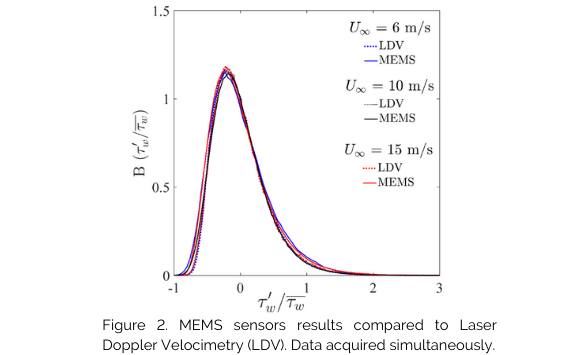MEMS wall-shear stress sensors
Optical wall-shear stress sensors capable of taking instantaneous measurements in both one and two dimensions.
Why measure wall-shear stress?
Whenever air flows over a commercial aircraft a thin layer of turbulence is generated close to the surface of the vehicle. The same turbulence occurs with a high speed train. It also happens when water flows around the hull of a ship.
This region of turbulence generates a resistive force - drag. In turn, this creates a wall-shear stress across the entire surface of the aircraft, train or ship. This wall-shear stress is typically responsible for more than half of the vehicle’s energy consumption.
Limitations of Existing Sensor Technology:
- Many of the existing sensors measure wall-shear stress indirectly
- Sensors are difficult to use and calibrate, and are expensive
- Some systems are not resilient and have a high failure rate.
- None of the current solutions can measure instantaneous wall-shear stress in two dimensions over a surface area
.png)
Figure 1 shows one of the designs used in the one-dimensional sensors. The sensors use Moiré Fringe transduction to amplify the movement on the floating element (figure 1B). The movement can be as small as tens of nanometres. LEDs and photodiodes detect the movement. The output from the photodiodes is used to directly measure the instantaneous wall-shear stress.
Laser Doppler Velocimetry (LDV) is seen as a "gold standard" measurement of fluid velocity, and can be used to indirectly measure wall-share stress. Our solution shows excellent agreement with LDV (figure 2).

Stage of Development
We have reached the proof-of-concept stage with this technology and two provisional patents have been filed.
- The sensors can be easily calibrated and only need to be calibrated once
- Six sensor types have been developed so far including
- 1-dimensional sensors
- 2-dimensional sensors
- 1-dimensional arrays
- 2-dimensional arrays
- The largest array to date is 4x4
- Smallest floating element to date is 300 µm x 600 µm
Benefits
- Accurately measure instantaneous wall-shear stress using a direct method
- Greater than 2% accuracy
- Measure flow in multiple directions (both 1D and 2D sensors)
- Can be supplied as arrays – greatly increasing the number of sensors available in given space.
- No need to calibrate – sensors can be supplied pre-calibrated
- Sensors can be flush mounted so not to interfere with turbulent flows
Contact
- Dr Luke Judd, Business Development Manger
- luke.judd@ncl.ac.uk
